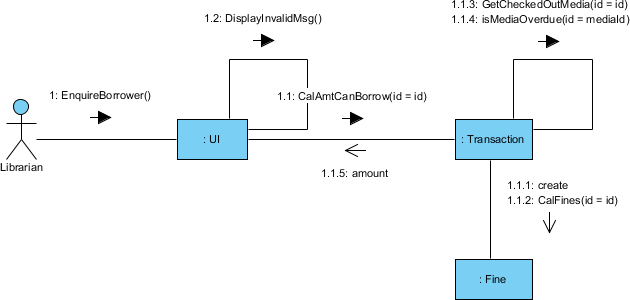Communication Diagram
A communication diagram is a type of interaction diagram in Unified Modelling Language (UML) that illustrates how objects interact within a system through messages. It emphasizes the structural organization of the objects that interact and the messages exchanged among them, rather than the time sequence of these interactions.
Communication Diagram
Key Components of Communication Diagrams
-
Objects and Actors
- Represented as labelled rectangles or ovals, indicating the participants in the interaction.
- Each object or actor is connected through lines to demonstrate their relationships.
-
Links
- Solid lines connecting the objects represent associations or links.
- Links indicate which objects can communicate with each other.
-
Messages
- Labelled arrows on the links denote messages sent from one object to another.
- Each message is numbered to indicate the sequence of interaction (e.g., 1, 2, 3).
- Optional parameters can be included in parentheses next to the message name.
-
Sequence Numbers
- Messages are numbered to show the order of interactions, facilitating an understanding of the communication flow.
- The numbering system indicates the sequence in which messages are exchanged.
Syntax of Communication Diagrams
- Objects: Represented as boxes labelled with the object’s name and class.
- Links: Solid lines connecting the objects represent associations.
- Messages: Labelled arrows along the links, with optional parameters in parentheses.
- Sequence Numbers: Indicate the order of messages.
Purpose and Usage
- Modelling Use Cases: Communication diagrams help model the interactions defined in use cases, providing insights into how objects collaborate to achieve specific functionality.
- Highlighting Structure: They emphasize the structural relationships between objects, showcasing how they are interconnected within the system.
- Facilitating Understanding: Useful for visualizing complex interactions in a more compact form compared to sequence diagrams.
Benefits of Communication Diagrams
- Clarity: Provide a clear representation of the relationships among objects and the messages exchanged, making them easier to understand for stakeholders.
- Compactness: More concise than sequence diagrams, allowing for a quicker grasp of object interactions without the temporal emphasis.
- Complementary Tool: Can be used alongside sequence diagrams to provide different perspectives on the same interactions.
